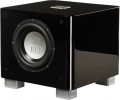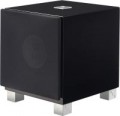Wireless connection
The presence of a
wireless connection in a subwoofer is most often Bluetooth: this standard is practically generally accepted in modern electronics, it is supported by the vast majority of smartphones, tablets and laptops. Note that we can talk about connecting an audio signal, as well as connecting to a device like a smartphone or tablet to manage settings. However, the latter option is not common — mainly in concert models, based on the ability to reconfigure the subwoofer even in a situation where there is no direct access to it.
If we talk about wireless sound transmission, then this option is convenient primarily from the point of view of choosing the optimal installation location: moving the subwoofer around the room, you do not need to mess with wires, and the Bluetooth range reaches 10 m. However, the quality of sound transmission with a wireless connection may be lower than with wired, but for bass this point is not as noticeable as for other frequency bands.
Inputs
Types and number of inputs provided in the design of the subwoofer. There can be several audio inputs of the same type — this is usually provided for signal switching (for example, to transmit sound to the rest of the acoustics through the built-in subwoofer crossover).
—
RCA (LFE). Dedicated input for connecting a low-frequency audio signal from a preamplifier; in fact, LFE means "low-frequency effects", and RCA is a type of connector (colloquially referred to as "tulip"). It is desirable to connect a signal to such an input from a specialized output “to a subwoofer” or from an external crossover. Note that the LFE input can be provided even in a subwoofer equipped with its own frequency filter: external crossovers often turn out to be of better quality than built-in ones. Most models with this output are domestic (see "Intended use").
—
RCA (linear). Input used to connect the audio signal from the preamplifier. At the same time, unlike the LFE described above, we are talking about all audio frequencies, and not just about bass. The presence of such a connector, usually, indicates the presence of a built-in crossover; also line inputs can be used for audio signal switching, including without processing it (if there are appropriate outputs, see below). Note that in analogue RCA, one connector is needed for each audio channel, so the specific number of connectors may be different; howev
...er, most often there are two of them — for a stereo signal.
— Jack (6.35 mm). Socket for 6.35 mm Jack. This interface is used to connect to both a preamplifier and a power amplifier; it is especially popular in professional studio equipment, although it is also found in other types of audio equipment, including home and concert. The 6.35 mm Jack provides good connection quality, connects and disconnects quickly (although the lack of a lock slightly reduces reliability), and can also be used for balanced audio (see "Balanced XLR" below), although support for this feature in each individual case should be clarified separately. at the same time, there are combo connectors that allow you to connect one of the plugs — Jack (6.35 mm) or XLR.
— Balanced XLR. Distinctive round 3-pin locking connector used for balanced analogue audio preamp connection. The peculiarity of this connection is that, due to the specific method of signal transmission, the cable itself plays the role of an interference suppressor, which allows the use of rather long wires without compromising the purity of the sound. Because of this, as well as the reliability of the connection, XLR has become very popular in high-end audio equipment, including studio and live equipment. One connector of this type is responsible for one channel of sound, therefore, in subwoofers with support for stereo signal switching, the XLR input can consist of 2 connectors; this may be specified in the specifications.
— Balanced digital ( AES/EBU). Professional interface for digital audio transmission. It uses the same connector and cable as the balanced XLR described above, but differs in signal type (besides, all channels are transmitted via one connector with this connection). At the same time, AES/EBU has all the advantages of a balanced connection, including high noise immunity even with long cable lengths. To reproduce such an audio signal on the subwoofer itself, it is necessary that the latter has not only an amplifier, but also its own DAC, which greatly complicates and increases the cost of the design. In addition, AES/EBU outputs are found mainly in high-end professional audio equipment. Thus, subwoofers with such an input are extremely rare, mainly among advanced models for studio and concert purposes. And even in such models, only the switching of a digital signal to a similar output can be provided, and not its reproduction.
— Speakon. Connector used in professional audio equipment to connect to a power amplifier. Its specific features are the ability to work with high currents and increased protection from human contact with live parts. This made the Speakon very popular in live gear; however, there are also home subwoofers (see "Intended use") with such inputs.
— High-level(terminals). Input for connecting a signal from a power amplifier. It is one of the most popular connection interfaces for passive subwoofers (see "Type"), however, it can also be provided in active ones — in case an external bass amplifier is available, better than the built-in one. One input provides a pair of terminals and allows you to transmit one channel of sound — this is enough when connecting a subwoofer to an external crossover. However, there can be two high-level inputs (and four terminals, respectively) — this means that the audio signal can be transmitted to the rest of the audio system components through the built-in crossover.
— Trigger. Service input used to automatically turn on the subwoofer. It is enough to connect the corresponding output of another audio system component (for example, an audio receiver) to the trigger input — and each time this component is turned on, the “sub” will receive a control signal and turn on too, which will save the owner from having to “wake up” the device separately.Outputs
—
RCA (linear). A standard interface for handling analogue audio from a preamplifier. In subwoofers, it is used to transmit a signal to other acoustic components, mainly in home models (see "Intended Use"), designed to build 2.1 systems. Usually, such a signal is pre-processed by a built-in crossover, which “selects” the bass frequencies for the subwoofer and outputs only the midrange and treble; however, in some models, direct switching of the audio signal is also possible, without separation into frequencies. In linear RCA, each channel of audio needs its own jack; accordingly, for the mentioned 2.1 systems, a pair of connectors is usually provided for one output.
—
RCA (LFE). The LFE interface is designed to work with a low frequency signal (bass). The presence of such a connector is useful, first of all, if you need to use a second subwoofer — not all players, receivers and other signal sources have enough of their own outputs for this, and it’s closer to pull the wire to the first “subwoofer”. Note that the second subwoofer must be active, otherwise it will require an additional amplifier.
—
Jack (6.35 mm). Socket for 6.35 mm Jack. This connector is mainly used in professional audio equipment, it can be used both for a linear signal and for a signal from a power amplifier. The output is intended for switching such a signal to other acoustic compon
...ents. The 6.35 mm jack provides good connection quality, connects and disconnects quickly (although the lack of a lock slightly reduces reliability), and can also be used for balanced audio (see "Balanced XLR" below), although support for this function in each individual case should be clarified separately.
— Balanced XLR. Characteristic round plug with 3 pins and lock. It is similar in purpose to the RCA line output described above (including the “1 channel per plug” principle), except that XLR is used mainly in professional audio equipment, and the connection is made in the so-called balanced format. Its peculiarity lies in the fact that due to the specific method of signal transmission, the cable itself plays the role of an interference suppressor, which allows the use of rather long wires without compromising the purity of the sound. Because of this, as well as the reliability of the connection, the XLR has become very popular in high-end equipment, including studio and live.
— Speakon. Professional connector designed to work with a signal from a power amplifier. Specially designed for high power sound, based on the reliability of the connection and the maximum protection of people from touching the contacts, and is used mainly in concert technology. Like any audio output, Speakon is used for signal switching (including connecting a passive speaker to a subwoofer amplifier, see above), while some subwoofer models may have built-in crossover processing.
— High-level (terminals). Interface for working with a signal from a power amplifier, normally used in home acoustics. The high-level output is often paired with a corresponding input and used to route an external audio signal from a power amplifier; while the sound is usually processed by the built-in crossover. There are also active subwoofers that can play the role of an external amplifier for passive acoustics and supply the terminals with an audio signal received from the line input and “swung up” to the desired power; see "Connecting a Passive Speaker" for details.Material
- MDF. Medium-density fiberboard is one of the most popular materials for modern speaker cabinets, including subwoofers. This is due, on the one hand, to the relatively low cost and neat appearance, and on the other hand, to excellent acoustic characteristics.
MDF cases are found in “subs” for all purposes and price categories.
- Tree. Natural wood is well suited for low-frequency acoustic enclosures; its performance characteristics are comparable to MDF described above. At the same time, this material is considered more “natural” and has its own beautiful surface pattern, but is noticeably more expensive. Therefore, although
wooden cases are common, they are not as widespread as MDF.
- Plastic. The main advantage of plastic is its low cost, but it is very difficult to create a body with the necessary acoustic characteristics from this material. Therefore,
plastic subwoofers are extremely rare, mostly built-in models.
- Metal. In this case, we mean various alloys and aluminium models. The metal is highly durable, but the acoustic characteristics are far from optimal. This requires the use of various tricks, which respectively affect the price
of a metal subwoofer. Therefore, this option is quite rare.

